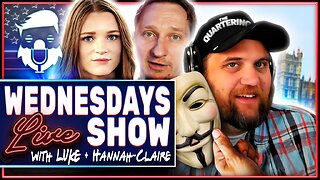Premium Only Content

Troubleshooting 3-Way Switches: Why Does My 3-Way Switch Only Work Sometimes?
Join this channel to get access to perks:
https://www.youtube.com/channel/UCB3jUEyCLRbCw7QED0vnXYg/join
Troubleshooting a non-working 3-way switch can be a reasonably large pain in the rear for any electrician or electrical contractor. In the latest episode of Electrician U, Dustin gives some Journeyman’s tips (well a Master’s tips really!!) that will make the process easier.
🤘⚡️MEMBERSHIP⚡️🤘
JOIN ELECTRICIAN U - become a member and get:
FREE Continuing Education every year
FREE Practice Exams
FREE Monthly Video Courses
FREE Weekly Live Instructor-Led Classes
FREE Monthly Educational Newsletter
Premium Members-Only Content
Private Discord Channel
Monthly Members-Only Discord Chats
Sign up here --- https://www.electricianu.com/electrician-u-membership/
🎧🎹MUSIC AND VIDEO:🎹🎧
https://www.facebook.com/descantmv
🎬✍️ART AND ILLUSTRATION:✍️🎬
https://www.daverussoart.com
So, you have a 3-way switch that only works from one side when the other switch is in one position or the other. In other words, if one switch is in the up position, the other switch will turn the light(s) on and off. But if you flip that other switch to the down position, the light(s) won’t actuate at all. This generally means that you have the travelers crossed and either the incoming hot or the outgoing switch leg on the wrong screws. A relatively easy fix once you can understand how a 3-way works and can visualize the process. PSA- always turn the power OFF before working on any electrical installation!
First, put on your troubleshooting/service electrician hat (figuratively of course!). A good tip- as you are unscrewing the device and pulling it & the wires out of the box, do it gently and slowly. A non-working 3-way may not be a miswiring issue as the source of your power issues but may in fact be loose wiring connections. If you pull something out to fast, you can change the state of the wiring and end up chasing ghosts! When you do get the device/wires pulled out of the box, check the connections on the device to make sure they are nice and tight. When putting switch/wires back in box, be careful not to pinch wires and make sure the bare ground wire doesn't come into contact with any of the screws on the device (with the exception of the green grounding screw of course!).
You may also want to check the wiring colors attached to the different color device screws. 3-way switches have 4 screws. A green one for the ground, a black/dark bronze one for either the incoming hot or the outgoing switch leg, and 2 brass/gold-colored screws for the travelers. Try to keep in mind that you will be bringing IN the power in one switch box and OUT to the fixture in the other box. Either of these locations will generally be done in a single 12-2 or 14-2 cable. The travelers (the wiring going in between the switches) will generally be done in a single 12-3 or 14-3 cable. So, the cable with the single black wire will go to the black screw on the device and the cable with the red and black wires will go to the brass/gold-colored screws. If you happen to see the single black wire attached to a brass-colored screw, then the travelers are crossed and that will generally be the source of your problem!
Depending on length (either the homerun or the traveler length in between the 2 switches) you may have to run the incoming hot and the travelers in #12 but the final switch leg up to the fixtures can be run in #14 (if it is a 15-amp circuit). So, another tip can be to look at wire size. If you look into the switchbox that is being used as the last box before it goes up to the fixture itself, if you see a #14 wire attached to a gold-colored screw, chances are you have something crossed.
In addition to the internal composition of the switches, you may notice that a 3-way switch does NOT have an ON/OFF label on the switch. Due to the alternating nature of the switches and being able to actuate from 2 different locations, they will change position each time you go in/out of different doors.
We hope this has been helpful in understanding how a 3-way switch works and some of the troubleshooting techniques to correct a non-working installation. Do you have a topic you would like to see discussed on Electrician U? Leave a comment in the comments section and let us know! please continue to follow Dustin and Electrician U as we are constantly updating our content to assist our followers in becoming the best electricians that they can be.
-
 0:58
0:58
Electrician U
1 year agoFISH STICKS! Every electrician needs these!
6.33K -
 1:09:44
1:09:44
Russell Brand
7 hours agoFrom Curb Your Enthusiasm to Courage — Cheryl Hines on Hollywood, RFK Jr. & Speaking Out - SF646
139K27 -
 1:30:26
1:30:26
The Quartering
5 hours agoWoke Is Back!
133K61 -
 1:18:21
1:18:21
DeVory Darkins
6 hours agoTrump issues CHILLING WARNING to GOP as SCOTUS hears arguments regarding Tariffs
119K107 -
 3:35:48
3:35:48
Barry Cunningham
7 hours agoBREAKING NEWS: PRESIDENT TRUMP SPEECH AT THE MIAMI BUSINESS FORUM! (MIKE JOHNSON PRESSER)
112K26 -
 2:04:47
2:04:47
The Charlie Kirk Show
6 hours agoOnward | Henderson, Laurie, Miles | 11.5.2025
115K26 -
 2:15:52
2:15:52
Steven Crowder
10 hours agoWho is the Real Myron Gaines | Ash Wednesday
367K488 -
 1:07:53
1:07:53
Sean Unpaved
5 hours agoRankings, Recaps, & Deadline Deals: CFB Shake-Ups & NFL Trades
60.6K3 -
 2:13:33
2:13:33
Side Scrollers Podcast
7 hours agoAsmongold SUED for Emotional Distress + Hasan REJECTED+ INSANE Plane Crash + More | Side Scrollers
71.4K17 -
 1:00:32
1:00:32
VINCE
10 hours agoNYC Has Been Seized By The Communists | Episode 162 - 11/05/25
303K507